Overview
This article delves into best practices for maximizing performance with the string_split function in SQL Server. It highlights essential strategies that include:
- Ensuring compatibility
- Avoiding use in WHERE clauses
- Utilizing temporary tables
- Validating outputs
These practices collectively enhance operational efficiency and streamline data processing tasks, ultimately providing actionable insights for professionals looking to optimize their SQL performance.
Introduction
In the realm of data management, efficiently manipulating strings is crucial for organizations aiming to harness the full potential of their datasets. The string_split function, introduced in SQL Server 2016, serves as a powerful tool for breaking down strings into manageable components. This capability significantly enhances data processing tasks. By transforming complex, comma-separated values into structured formats, this function simplifies workflows and boosts productivity, paving the way for informed decision-making.
As SQL Server continues to evolve, anticipated advancements promise even greater capabilities. It is essential for businesses to grasp the intricacies of string_split and its applications in real-world scenarios. This exploration delves into the benefits, challenges, and best practices associated with this function. It offers insights into how organizations can optimize their data handling processes and drive growth in an increasingly data-driven landscape.
Understanding the string_split Function: A Key to Efficient Data Handling
The string_split function, introduced in SQL Server 2016, serves as a robust solution for disaggregating strings into individual components based on a specified delimiter. This table-valued procedure produces a single-column table where each row corresponds to a substring. For instance, executing SELECT value FROM STRING_SPLIT('apple, banana,cherry', ',') yields three distinct rows: ‘apple’, ‘banana’, and ‘cherry’.
This functionality is particularly advantageous for managing comma-separated values, significantly enhancing processing tasks by simplifying the manipulation of lists contained within a single string.
The benefits of employing the string_split method extend beyond mere convenience. It streamlines workflows by diminishing the complexity associated with parsing strings, thereby boosting overall handling efficiency. Organizations have reported a notable increase in productivity when leveraging this feature for information extraction and transformation tasks.
For example, companies utilizing the function have automated the processing of large datasets, resulting in quicker decision-making and more accurate insights. This trend aligns with the broader movement towards Robotic Process Automation (RPA) to enhance operational efficiency in a rapidly evolving AI landscape, a key focus of Creatum GmbH’s solutions.
As SQL Server evolves, anticipated enhancements in the handling capabilities of the string_split feature for SQL Server 2025 promise to further improve functionality. The proposed STRING_SPLIT_WK method is expected to produce an output format that includes a key indicating the sequence of values in the original string, thereby enhancing the method’s utility in scenarios requiring ordered information retrieval. As Aaron Bertrand notes, “It doesn’t even have to guarantee the values would be returned in that order, because I can explicitly say ORDER BY [key] (or add other functionality, like return only the first, last, or nth price).”
This advancement aligns with the growing demand for efficient information processing solutions in an increasingly information-driven landscape, underscoring the significance of Business Intelligence and RPA in driving insights and operational efficiency for business growth, a key offering of Creatum GmbH.
Expert opinions underscore the importance of utilizing the string_split function in contemporary information management practices. By enabling the breakdown of complex strings into manageable components, it empowers organizations to harness the full potential of their information, fostering growth and innovation. Creatum GmbH’s case study titled ‘Customized Solutions for Quality‘ illustrates how their solutions enhance quality and simplify AI implementation, ultimately driving growth and innovation for businesses.
As companies continue to navigate the complexities of data processing, this tool remains an essential resource for enhancing operational efficiency and ensuring high-quality data results. For further insights and resources, professionals can refer to MSSQLTips.com, which offers valuable information on SQL Server functionalities.
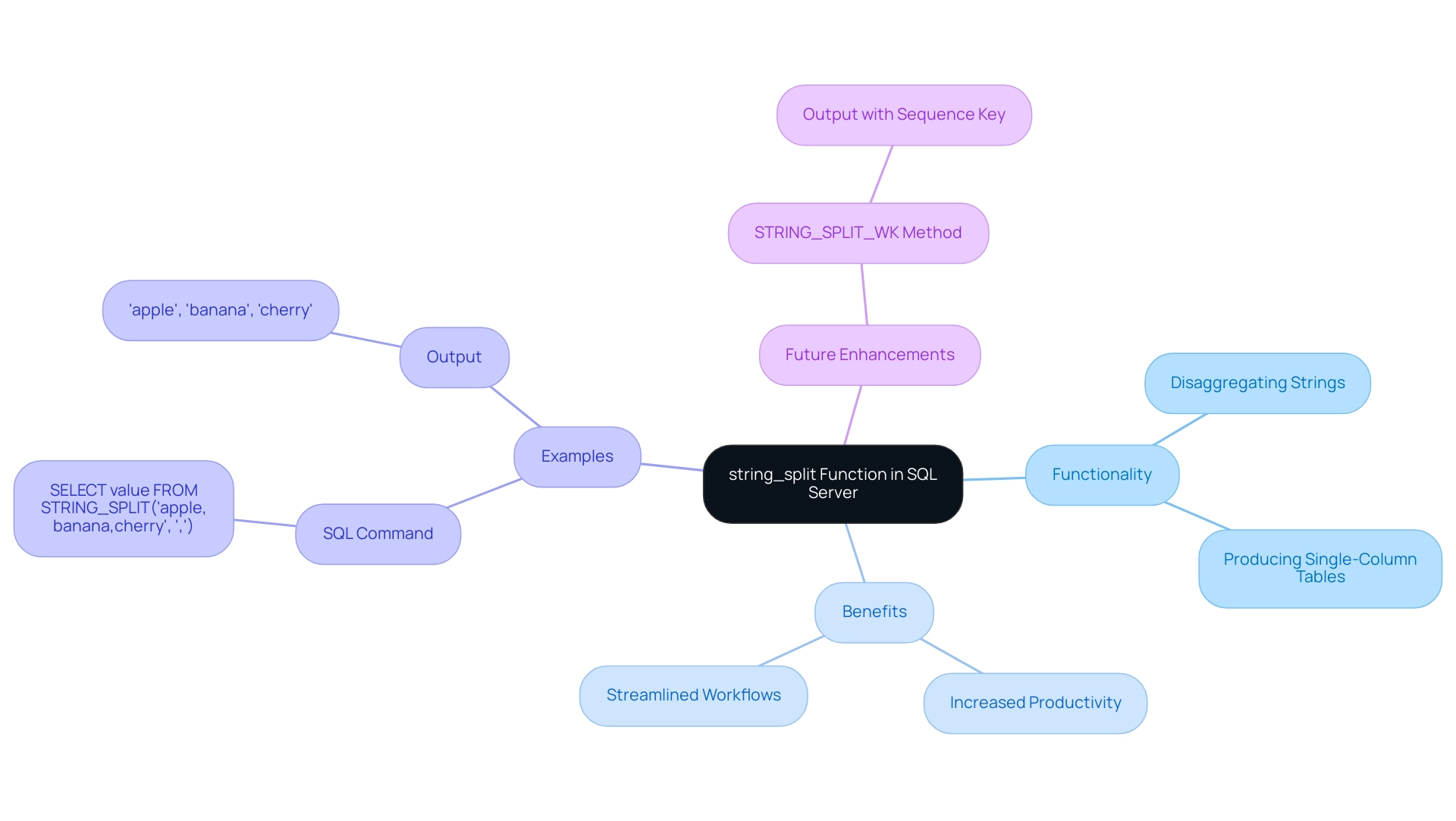
Common Challenges with string_split: Identifying and Overcoming Limitations
The string_separate method in SQL Server serves as a powerful tool for parsing strings, yet it presents several limitations that users must navigate. One notable constraint is its support for only single-character delimiters, which can pose a significant hurdle when dealing with more intricate string formats. This limitation restricts the function’s applicability in scenarios where multi-character delimiters are necessary.
Moreover, the order of the output produced by the splitting function is not guaranteed. This implies that the substrings returned may not preserve the original order from the input string, potentially complicating analysis and interpretation. Additionally, the function does not inherently remove duplicates from the output, leading to unnecessary entries that may distort analysis if not handled correctly.
To efficiently tackle these challenges, users can preprocess their strings to standardize delimiters before applying the string_split function. This preprocessing step enhances the utility of the operation by ensuring that the input is formatted correctly. Furthermore, employing additional SQL functions such as DISTINCT or GROUP BY can help sort and filter the results after the split, allowing for a more refined output that meets specific analytical needs.
For instance, organizations that have implemented robotic process automation (RPA) through Creatum GmbH have successfully streamlined their workflows by addressing such information manipulation challenges. In a case study, a mid-sized company improved efficiency by automating information entry and software testing, which were previously hindered by manual, repetitive tasks. This implementation of RPA not only enhanced operational efficiency and reduced errors but also allowed teams to focus on strategic initiatives, ultimately driving growth and innovation.
Additionally, Creatum GmbH offers tailored AI solutions and Business Intelligence that can further assist organizations in navigating the rapidly evolving AI landscape. As SQL Server progresses, especially with the improvements brought by SQL Server 2022, comprehending and addressing the limitations of the string_split function will be essential for optimizing performance and maintaining data integrity.
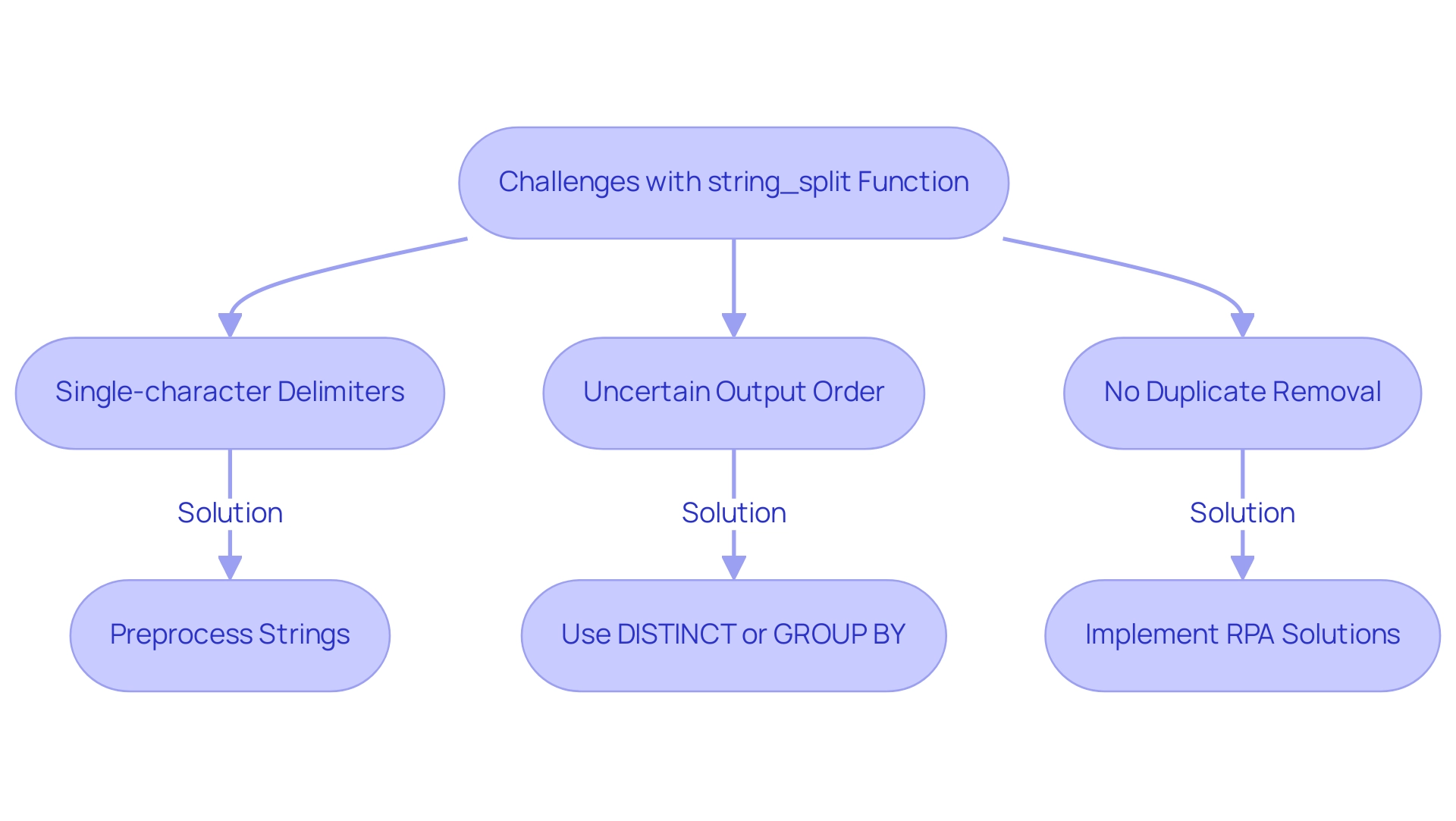
Best Practices for Using string_split: Ensuring Optimal Performance
To achieve optimal performance with the string_split function in SQL Server, follow these best practices:
- Check Compatibility Level: Ensure your SQL Server instance operates at a compatibility level of at least 130. This is essential for effectively utilizing
string_split. - Strategic Placement: Avoid using the function within WHERE clauses, as this can significantly hinder performance. Instead, leverage it in SELECT statements or JOIN operations to maintain efficiency.
- Utilize Temporary Tables: If you anticipate handling a substantial number of substrings, consider employing a temporary table to store the results. This approach can enhance performance by reducing memory overhead and streamlining information processing.
- Validate Outputs: Always validate the output of the function to ensure it aligns with your expectations, particularly when dealing with complex strings. This step is crucial for maintaining data integrity and accuracy.
Incorporating these practices not only optimizes the performance of the string_split function but also aligns with broader strategies for enhancing operational efficiency through Robotic Process Automation (RPA) at Creatum GmbH. As organizations increasingly leverage RPA to automate manual workflows, they can significantly reduce errors and free up resources for more strategic tasks. As Jeff Moden aptly noted, “Divide’n’Conquer is a VERY effective performance tool and not just when it comes to functions and the like.”
Organizations that have adopted these best practices report significant advancements in their processing capabilities, enabling them to extract actionable insights more effectively. For instance, the case study titled ‘Business Intelligence Empowerment’ illustrates how organizations transformed raw information into actionable insights, facilitating informed decision-making. By focusing on performance optimization and integrating RPA, businesses can drive growth and innovation, transforming their data-rich environments into valuable resources for informed decision-making.
Moreover, with SQL Server 2022 introducing advanced time series capabilities, the potential for optimizing performance continues to expand. It is essential for organizations to adopt these best practices to stay ahead.
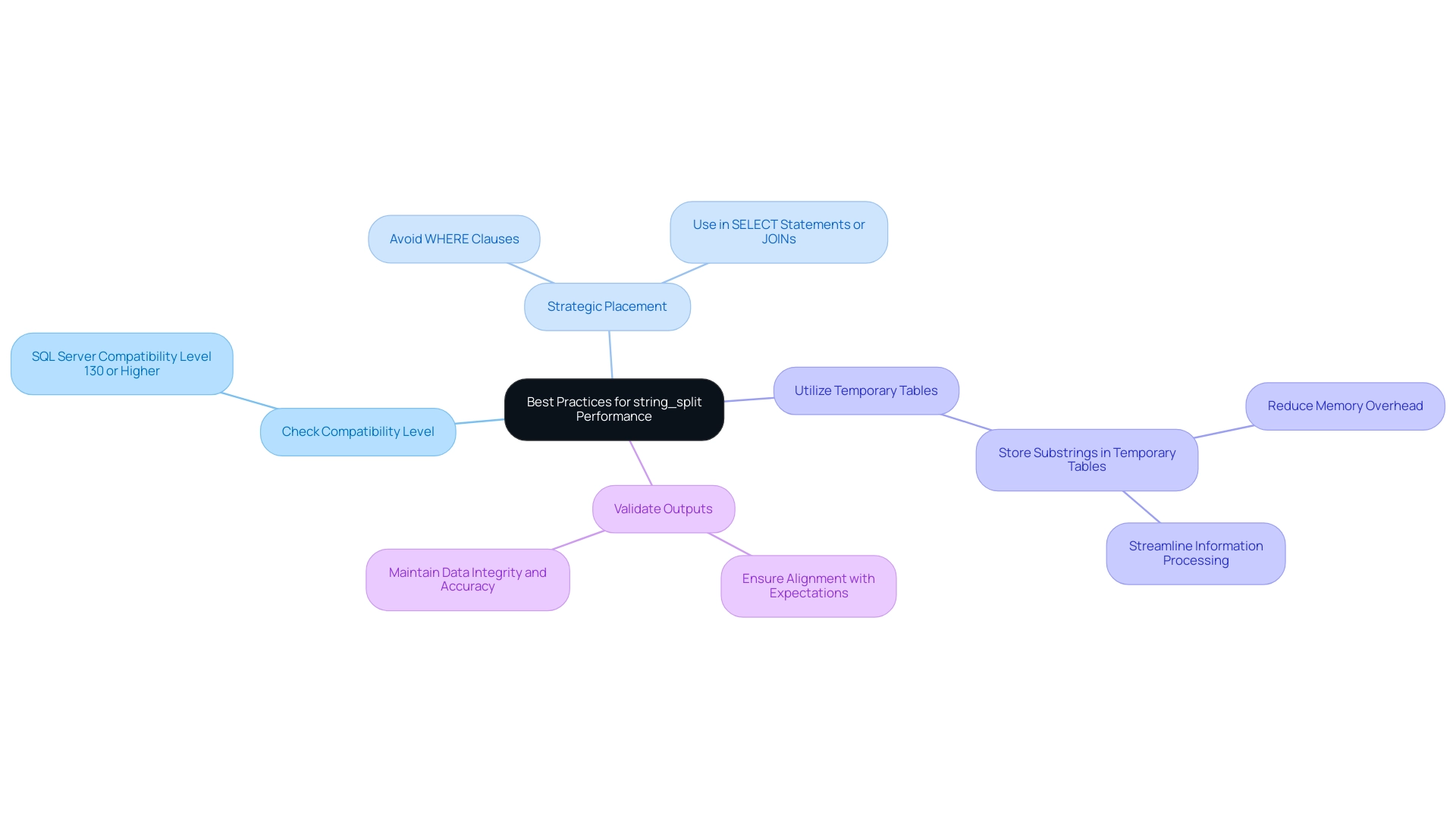
Exploring Alternatives to string_split: When and Why to Use Different Approaches
Beyond the use of string_split, SQL Server offers various alternative methods for effective string manipulation, which can be enhanced through Robotic Process Automation (RPA). One notable approach is XML parsing, excelling in handling complex delimiters and multi-character separators. This method is particularly beneficial when the structure demands a more nuanced splitting technique, enabling the automation of repetitive tasks that can significantly hinder operations.
Moreover, creating a custom user-defined procedure (UDF) allows for tailored solutions that maintain the order of substrings and filter out duplicates, effectively addressing specific data processing needs. It is advisable to name custom procedures as string_split for compatibility with SQL Server 2016 and newer, ensuring seamless integration and operational efficiency.
Another modern option is the OPENJSON method, advantageous for strings formatted as JSON arrays. This function not only simplifies the parsing process but also aligns well with contemporary formats, making it a valuable tool for developers keen on leveraging RPA in their workflows.
Each of these alternatives presents unique benefits and should be evaluated based on the specific context of the information being processed. For instance, while the string_split function is straightforward, it does not guarantee the order of output rows, a critical factor in certain applications. Case studies highlight that options like DelimitedSplit8k_LEAD and JSON Splitter provide enhanced functionality, including support for multiple character delimiters and the ability to retrieve ordinal positions, thus offering more reliable information manipulation solutions.
Thom A. from Rant SQL Server notes that “DelimitedSplit8k_LEAD is a great alternative to ensure you get the ordinal position when splitting.”
It is essential to note that the string_split function requires a compatibility level of at least 130 in SQL Server. Ultimately, selecting the right method hinges on understanding the specific requirements of the task at hand and leveraging the strengths of each approach, particularly in the context of driving data-driven insights and operational efficiency for business growth. Furthermore, the integration of Business Intelligence is crucial as it transforms raw information into actionable insights, enabling informed decision-making that drives growth and innovation.
By addressing the challenges posed by manual, repetitive tasks, Creatum GmbH can enhance operational efficiency and streamline workflows effectively.
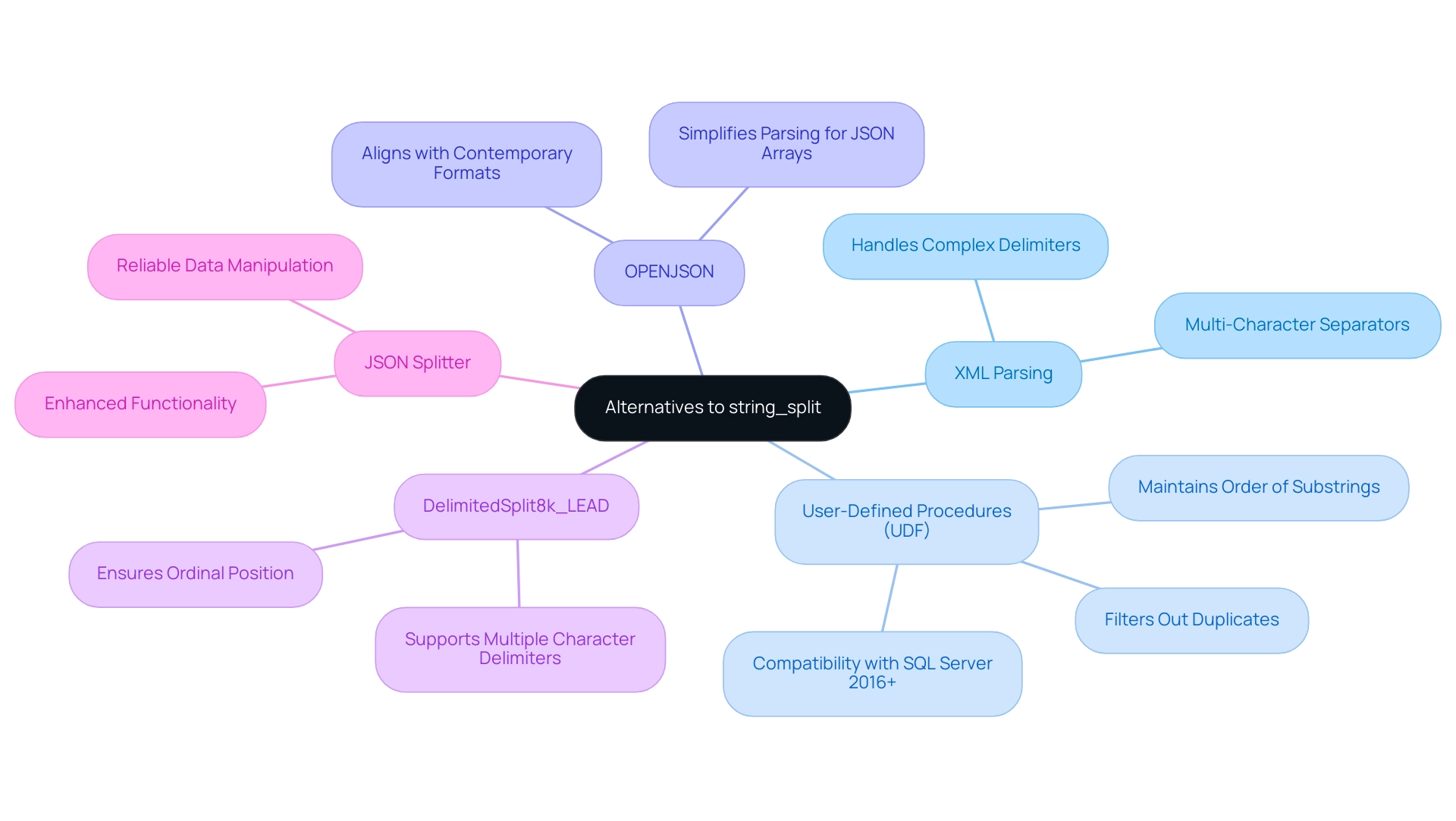
Real-World Applications of string_split: Enhancing Operational Efficiency
The function serves as a powerful tool in various real-world applications, significantly enhancing operational efficiency across multiple domains. In migration projects, for example, the function effectively parses and transforms comma-separated values from legacy systems into structured formats compatible with modern databases. This capability streamlines the migration process and minimizes the risk of loss or corruption, aligning with the goals of Robotic Process Automation (RPA) to automate manual workflows and enhance operational efficiency, particularly through solutions like EMMA RPA and Microsoft Power Automate offered by Creatum GmbH.
In reporting applications, the function string_split excels at extracting individual elements from concatenated fields, facilitating more granular analysis. This level of detail enables organizations to extract deeper insights from their information, ultimately supporting more informed decision-making. As cbeleites aptly notes, “Do not confuse a single random split into train and test with a properly designed study to measure prediction quality,” emphasizing the importance of structured approaches in analysis. This is crucial for driving insights and operational efficiency for business growth.
Furthermore, the function plays a vital role in ETL (Extract, Transform, Load) processes, where it is used to clean and prepare information for analysis. By ensuring that information integrity is maintained throughout the workflow, organizations can trust the quality of their insights, leading to better strategic outcomes. The incorporation of cardinality estimation feedback can further improve query execution plans, optimizing the use of the split function in these processes.
As SQL Server 2025 progresses, improvements in functionalities like string_split will further enable companies to enhance their information management procedures. The launch of advanced time series features in SQL Server 2022, such as DATE_BUCKET and GENERATE_SERIES, has already established a standard for enhanced manipulation abilities, paving the way for even more sophisticated uses of string_split in operational efficiency initiatives. A relevant case study titled “Business Intelligence Empowerment” illustrates how organizations can extract meaningful insights from data, supporting informed decision-making and driving growth and innovation while leveraging AI solutions to improve data quality and training.

Integrating string_split with Other Functions: Maximizing Its Utility
To fully harness the capabilities of string_split, it is imperative to integrate it with other SQL operations. By employing CROSS APPLY alongside a string-splitting function, one can join the resulting substrings with additional tables, paving the way for more complex queries that reveal deeper insights. As Ronen Ariely highlights, “There is a simple solution for using STRING_SPLIT and guarantee the order, but it is highly not recommended for production, from the performance aspect.”
This underscores the importance of selecting the right combination of operations for optimal performance.
For instance, when analyzing a dataset comprising 230,000 rows, utilizing STUFF with FOR XML PATH has demonstrated a significant performance edge over alternative methods. Moreover, integrating this technique with aggregate operations like COUNT or SUM can illuminate the frequency of specific values within your dataset, yielding valuable insights into trends. This methodology not only enhances analysis but also empowers informed decision-making, transforming raw data into actionable insights that align with our organization’s mission to elevate quality and streamline AI implementation.
Incorporating filtering functions such as WHERE or HAVING in conjunction with string_split amplifies the ability to refine results based on targeted criteria, thus enhancing the overall efficacy of your queries. Leveraging Robotic Process Automation (RPA) to automate these manual workflows, which frequently involve repetitive tasks, allows organizations to significantly enhance operational efficiency and minimize errors, enabling teams to concentrate on strategic initiatives. Real-world applications, as illustrated in the case study ‘Business Intelligence Empowerment,’ reveal that organizations employing these combinations can achieve remarkable improvements in operational efficiency and information quality, ultimately fostering growth and innovation.
Furthermore, grasping how data manipulation intersects with advertising and profiling can provide additional context regarding the critical nature of effective data management in today’s data-rich landscape.
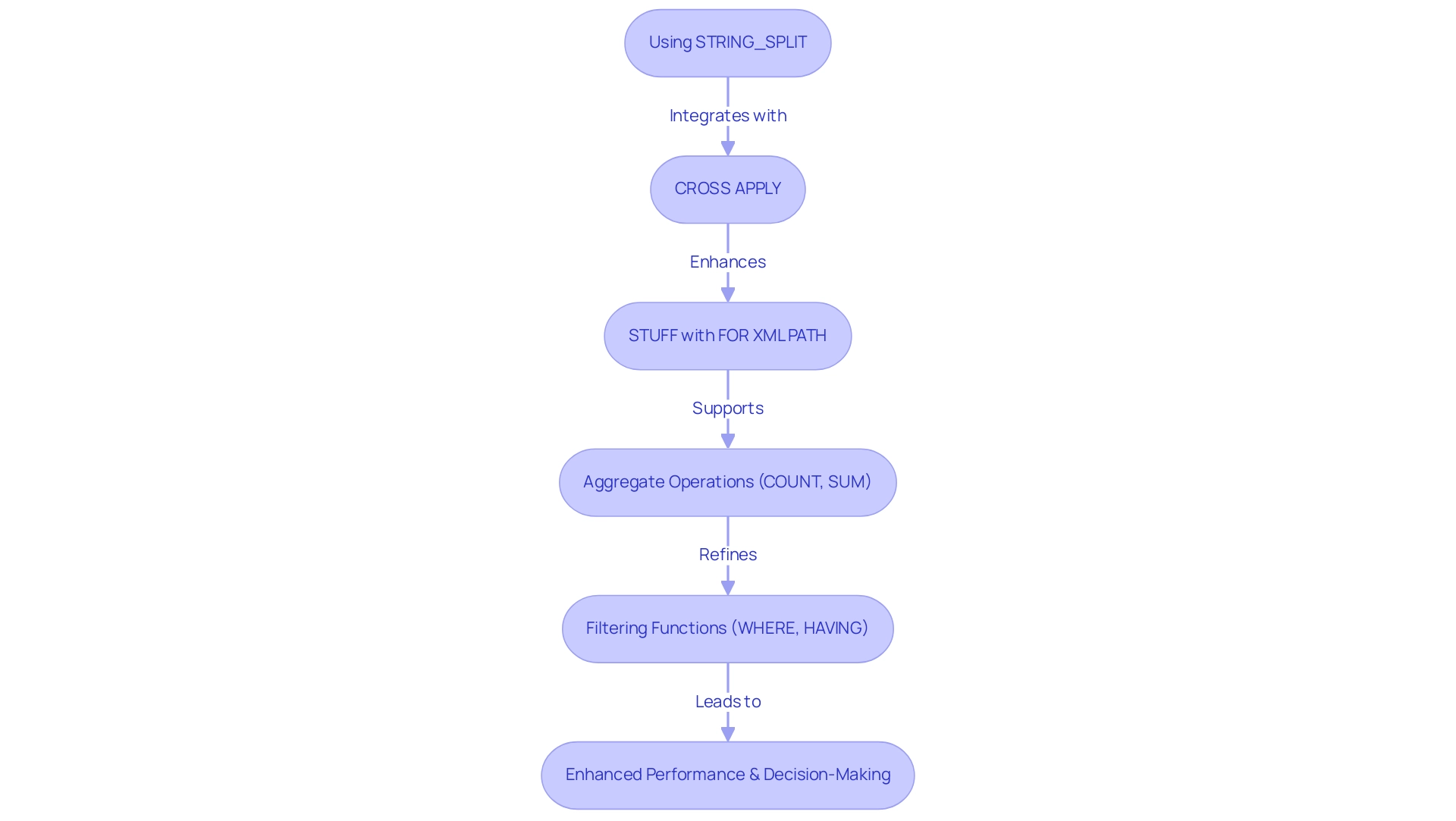
Conclusion
The string_split function in SQL Server is pivotal for enhancing data management efficiency. By breaking complex strings into manageable components, it simplifies the processing of comma-separated values, streamlining workflows and boosting productivity. Anticipated advancements like STRING_SPLIT_WK promise to further enhance its capabilities, addressing the demands of an evolving data landscape.
However, string_split has limitations, including its restriction to single-character delimiters and unpredictable output order. Organizations can mitigate these challenges through preprocessing and by employing additional SQL functions for refined results. Best practices, such as strategic placement in queries and the use of temporary tables, are essential for optimizing performance and ensuring data integrity.
Exploring alternatives like XML parsing and the OPENJSON function can also yield tailored solutions for specific needs. Each method presents unique advantages that merit evaluation based on the context of the data being processed.
Integrating string_split with other SQL functions maximizes its utility, enabling organizations to transform raw data into actionable insights. By adopting these tools and strategies, businesses can enhance their data handling processes, ensuring high-quality outcomes that support informed decision-making in a competitive environment. Embracing these approaches will be crucial for driving growth and innovation in today’s rapidly evolving data landscape.
Frequently Asked Questions
What is the string_split function in SQL Server?
The string_split function, introduced in SQL Server 2016, is a table-valued procedure that disaggregates strings into individual components based on a specified delimiter, producing a single-column table where each row corresponds to a substring.
How does the string_split function enhance data processing?
It simplifies the manipulation of lists contained within a single string, streamlining workflows by reducing the complexity associated with parsing strings. This leads to increased productivity and efficiency in information extraction and transformation tasks.
What are the advantages of using the string_split function for organizations?
Organizations report improved operational efficiency and faster decision-making when using the string_split function, as it automates the processing of large datasets and enhances the accuracy of insights.
What improvements are expected in the string_split function for SQL Server 2025?
The anticipated STRING_SPLIT_WK method is expected to include a key indicating the sequence of values in the original string, enhancing its utility for ordered information retrieval.
What limitations does the string_split function have?
The string_split function supports only single-character delimiters, does not guarantee the order of output, and does not remove duplicates from the output.
How can users address the limitations of the string_split function?
Users can preprocess their strings to standardize delimiters before using the function and employ additional SQL functions like DISTINCT or GROUP BY to refine the output after the split.
How does Creatum GmbH utilize the string_split function in their solutions?
Creatum GmbH leverages the string_split function to enhance operational efficiency and streamline workflows, particularly in robotic process automation (RPA), helping organizations improve data handling and reduce errors.
Where can professionals find more insights on SQL Server functionalities?
Professionals can refer to MSSQLTips.com for valuable information and resources regarding SQL Server functionalities.
